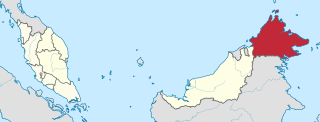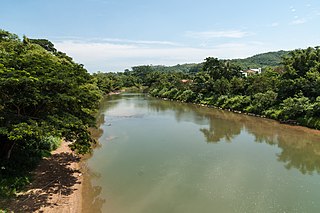Related Research Articles

Sabah is a state of Malaysia located on the northern portion of Borneo, in the region of East Malaysia. Sabah has land borders with the Malaysian state of Sarawak to the southwest and Indonesia's Kalimantan region to the south. The Federal Territory of Labuan is an island just off the Sabah coast. Sabah shares maritime borders with Vietnam to the west and the Philippines to the north and east. Kota Kinabalu is the state capital city, the economic centre of the state, and the seat of the Sabah state government. Other major towns in Sabah include Sandakan and Tawau. As of the 2015 census in Malaysia, the state's population is 3,543,500. Sabah has an equatorial climate with tropical rainforests and abundant animal and plant species. The state has long mountain ranges on the west side which forms part of the Crocker Range National Park. Kinabatangan River, the second longest river in Malaysia runs through Sabah, and Mount Kinabalu is the highest point of Sabah as well as of Malaysia.

The saltwater crocodile is a crocodilian native to saltwater habitats and brackish wetlands from India's east coast across Southeast Asia and the Sundaic region to northern Australia and Micronesia. It has been listed as Least Concern on the IUCN Red List since 1996. It was hunted for its skin throughout its range up to the 1970s, and is threatened by illegal killing and habitat loss. It is regarded as dangerous for people who share the same environment.

The Madras Crocodile Bank Trust and Centre for Herpetology (MCBT) is a reptile zoo and herpetology research station, located 40 kilometres (25 mi) south of the city of Chennai, in state of Tamil Nadu, India. The centre is both a registered trust and a recognized zoo under the Wildlife (Protection) Act, 1972 and comes under the purview of the Central Zoo Authority, Ministry of Environment and Forests, Government of India. It was established with the aim of saving three Indian endangered species of crocodile—the marsh or mugger crocodile, the saltwater crocodile, and the gharial, which at the time of founding of the trust were all nearing extinction.

The Kinabatangan River is a river in Sandakan Division, northeastern Sabah of Malaysia. It is the second longest river in Malaysia with a length of 560 km (350 mi) from its headwaters in the mountains of southwest Sabah, to its outlet at the Sulu Sea, east of Sandakan. The area is known for its high-biodiversity habitats including its limestone caves at Gomantong hill, dryland dipterocarp forests, riverine forest, freshwater swamp forest, oxbow lakes and salty mangrove swamps near the coast.

The Siamese crocodile is a medium-sized freshwater crocodile native to Indonesia, Brunei, East Malaysia, Laos, Cambodia, Myanmar, Thailand and Vietnam. The species is critically endangered and already extirpated from many regions. Its other common names include Siamese freshwater crocodile, Singapore small-grain, and soft-belly.

The Gomantong Caves are an intricate cave system inside Gomantong Hill in Sandakan Division, Sabah, Malaysia. The hill is the largest limestone outcrop in the Lower Kinabatangan area.

The Bornean ferret-badger, also known as Everett's ferret-badger or the Kinabalu ferret-badger, is a member of the family Mustelidae. The scientific name commemorates British colonial administrator and zoological collector Alfred Hart Everett.

The Department of Wildlife and National Parks of Peninsular Malaysia, abbreviated PERHILITAN, is a governmental organisation that is responsible for the protection, management and preservation of wildlife and national parks in Peninsular Malaysia.

The Philippine crocodile, also known as the Mindoro crocodile, the Philippine freshwater crocodile, the bukarot in Ilocano, and more generally as a buwaya in most Filipino lowland cultures, is one of two species of crocodiles found in the Philippines; the other is the larger saltwater crocodile (Crocodylus porosus). The Philippine crocodile, the species endemic only to the country, became data deficient to critically endangered in 2008 from exploitation and unsustainable fishing methods, such as dynamite fishing. Conservation methods are being taken by the Dutch/Filipino Mabuwaya foundation, the Crocodile Conservation Society and the Zoological Institute of HerpaWorld in Mindoro island. It is strictly prohibited to kill a crocodile in the country, and it is punishable by law.
The Wildlife Conservation Enactment 1997 is a regional piece of legislation enforced only in the state of Sabah in Malaysian Borneo. Its aim is to protect the endangered species of fauna and flora in the region as well as control international trade of these species. It also details specific punishments for those that break the rules and regulations put forth in the enactment.
Malaysian Wildlife Law consists of the regulation, protection, conservation and management of wildlife in Malaysia. The Constitution of Malaysia empowers those at the federal and the states level to make laws regarding wildlife resources. As such, eleven states in peninsular are managed under an act while Sabah enacted an enactment and Sarawak an ordinance.

The Amaravathi Dam is a dam constructed across the Amaravathi River. It is located at Amaravathinagar, 25 kilometres (16 mi) south of Udumalpet on SH 17 in the Indira Gandhi Wildlife Sanctuary, Tirupur district in the Indian state of Tamil Nadu. The associated Amaravathi Reservoir is 9.31 square kilometres (3.59 sq mi) in area and 33.53 metres (110.0 ft) deep. The dam was built primarily for irrigation and flood control and now also has four megawatts of electrical generating capacity installed. It is notable for the significant population of mugger crocodiles living in its reservoir and catchment basin.

The environment of Malaysia is the biotas and geologies that constitute the natural environment of Malaysia. Malaysia's ecology is megadiverse, with a biodiverse range of flora and fauna found in various ecoregions throughout the country. Tropical rainforests encompass between 59% to 70% of Malaysia's total land area, of which 11.6% is pristine. Malaysia has the world's fifth largest mangrove area, which totals over a half a million hectares.

Deforestation in Borneo has taken place on an industrial scale since the 1960s. Borneo, the third largest island in the world, divided between Indonesia, Malaysia and Brunei, was once covered by dense tropical and subtropical rainforests.
The Department of Orang Asli Development, abbreviated JAKOA, is the Malaysian government agency entrusted to oversee the affairs of the Orang Asli. This body is under the Malaysian Ministry of Rural Development and was first set up in 1954.

The Bornean Sun Bear Conservation Centre is a wildlife conservation and research centre for improving animal welfare and rehabilitation of the Malayan sun bear. It also aims to raise public awareness about the plight of the sun bears and to raise conservation awareness about this species.

Agop Batu Tulug Caves is an archaeological site in the Malaysian state of Sabah and refers to a group of several caves in a steep limestone cliffs in the Kinabatangan district.
Lumuyu Petroglyphs or also called as Lumuyu Rock Carvings comprising several petroglyphs situated not far from the Bekuku Village in Ulu Tomani of Tenom District in Sabah, Malaysia.

The Tuaran River is a river in West Coast Division, northwestern Sabah of Malaysia. It has a total length of 80 km (50 mi) from its headwaters in the mountains of northwest Sabah to its outlet at the South China Sea, northwest of Tuaran town.

The Sugut River is a river in Sandakan Division, northeastern Sabah of Malaysia. It has a total length of 178 km (111 mi) from its headwaters in the mountains of northwest Sabah to its outlet at the Sulu Sea, northeastern of Beluran town. Its source is originated from the mountains in the eastern slopes of Mount Kinabalu National Park in Ranau District, which part of the Mount Kinabalu system.
References
- ↑ "About" . Retrieved 2007-11-12.
- ↑ "About Sabah Wilderness Department, Services" . Retrieved 2007-11-12.